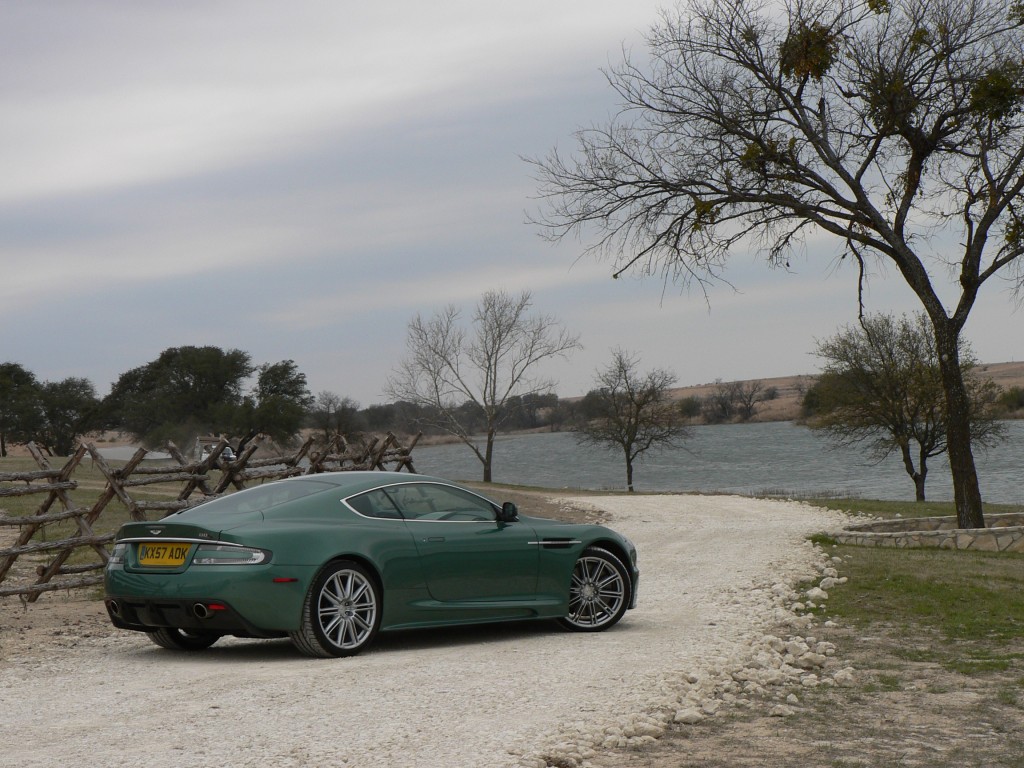First Drive: 2009 Aston Martin DBS
Story and photos by John LeBlanc
DALLAS–Unlike other exotic brands like Ferrari or Porsche that have been consistently in the sports car spotlight for decades, Aston Martin’s long history of fading in and out of insolvency has sometimes meant lapses between new cars.
But since the British automaker’s amicable divorce from 20-year steward Ford last year, four new production models have been produced and a fifth, the four-door Rapide, is scheduled for its production debut later next year.
Now owned by a Kuwaiti-based consortium, the exotic automaker’s latest independent offering, the 2009 Aston Martin DBS, made its North American debut in this region fuelled by the profits of oil.
Unofficially, as the largest, fastest and meanest-looking Aston, the DBS replaces the Vanquish as the new range topper.
Officially, Aston says the new DBS, of which 700 will be made worldwide (based previous sales ratios, expect 12 to 16 in Canada this year), bridges the product gap between the existing DB9 Coupe (which the DBS is heavily based upon) and last year’s Le Mans-winning DBR9 racecar.
Yet the more rational question lingers: does the new $290,000 DBS warrant its near $100,000 price premium over the already not-too-shabby $192,800 DB9 Coupe?
Most aficionados of Aston Martin will recognize the DBS’s classic engine-out-front, power-to-the-back grand touring design heritage that goes back to the marque’s 1958 DB4.
From five metres away the DBS’s distinctive unpainted carbon-fibre black weave on its hood, front fenders, and trunk lid peek out like ripped muscles through a tight shirt.
Although the roof and the doors are shared with the DB9, the DBS is wider. Interior dimensions remain the same, except the newer Aston Martinnow becomes a true two-seater. Luggage space has replaced the DB9’s two small rear spousal seats.
European buyers can order sport seats with a carbon shell that shed an additional 20 kg. But in total, North American DBSs weigh only 18 kg less than a DB9.
Whereas Aston currently uses a variation of a Volvo key fob, the automaker is quite proud of its first very own unit being introduced on the DBS.
Costing around $6 million to develop, the sapphire fob (or Emotional Control Unit in Aston-speak) slips into the dashboard and glows when it’s ready to be fired. And fire it does, with automated 2000 rpm blats that give off LeMans pit lane-type vibes.
A new inlet manifold and cylinder heads with better inlet-port design are the main reasons the DBS sports 510 horsepower; 60 more than the DB9’s similar 5.9 L V12. However, torque peak is unchanged at 420 lb.-ft.
A six-speed Graziano transaxle is the only transmission available. Surprisingly, the clutch is lighter than in the baby Aston – the V8 Vantage – and its gear change doesn’t engage as confidently either.
Neither Bach nor the Beatles nor the Beastie Boys have anything over the sounds coming from the DBS’s robust pipes. The basso, metallic exhaust first heard on start up becomes even more profundo when the throttle is mashed.
The claimed 4.3 seconds 0-to-96 km/h time and 300 km/h top speed won’t beat a $99,600 Dodge Viper SRT10 Coupe. But then, the Dodge’s truck-like exhaust sound is the antithesis to the DBS’s addictive mill music.
On the back roads south of Dallas, the DBS reveals its grand touring bones, feeling big and heavy.
There’s more than enough grip from the 20-inch Pirelli PZeros. And with so much torque on hand, surprisingly the big V12 has no problem playing in its upper rev bands. In fact, the engine encourages long stays in the 5500-6500 rpm range.
But no matter what setting you choose for the adjustable dampers, you never feel connected to the road. And although accurate, the steering could use some more feel to better place this wide beast in tight corner.
Things changed inside the DBS, however, once it was given some room to stretch its lengthy legs on some open Texas four-lane.
Short blasts up to the 210 to 220 km/h range delivered a composed stability that alludes to its LeMans racecar-like bodywork. At those elevated speeds, the steering and chassis of the car blend together as well, feeling much happier carrying out the task at hand.
But so does the DB9, for that matter. Rationally, that’s the biggest beef with the DBS – though rational emotions play little in the minds of most Aston owners.
“Nobody really needs an Aston Martin,” said one of the company’s spokespeople.
And the DBS confirms the brand’s status as a desirable luxury item – at least among those looking for something a little more extroverted than the usually restrained Aston fare.
PRICE: base: $290,000
ENGINE: 6.0 L V12
POWER/TORQUE: 510 hp/420 lb.-ft.
FUEL CONSUMPTION: (Est.) City 20.9; hwy. 12.3 L/100 km:
COMPETITION: Audi R8, Ferrari 599 GTB Fiorano, Lamborghini Murciélago, LP640, Porsche 911 GT2
WHAT’S BEST: Engine’s symphonic sounds; racy carbon-fibre bodywork; exclusivity
WHAT’S WORST: Wayward steering; inaccurate gear change; questionable performance value over nearly $100,000 cheaper DB9
WHAT’S INTERESTING: The DBS’s crystal sapphire and stainless steel fob cost nearly $6 million to develop
Comments
2 Responses to “First Drive: 2009 Aston Martin DBS”






![[del.icio.us]](https://www.straight-six.com/wp-content/plugins/bookmarkify/delicious.png)
![[Digg]](https://www.straight-six.com/wp-content/plugins/bookmarkify/digg.png)
![[Facebook]](https://www.straight-six.com/wp-content/plugins/bookmarkify/facebook.png)
![[Google]](https://www.straight-six.com/wp-content/plugins/bookmarkify/google.png)
![[Reddit]](https://www.straight-six.com/wp-content/plugins/bookmarkify/reddit.png)
![[StumbleUpon]](https://www.straight-six.com/wp-content/plugins/bookmarkify/stumbleupon.png)
![[Twitter]](https://www.straight-six.com/wp-content/plugins/bookmarkify/twitter.png)
![[Email]](https://www.straight-six.com/wp-content/plugins/bookmarkify/email.png)
February 8th, 2010 @ 1:52 am
[…] 180 km/h) and power. Unfortunately, Aston officials wouldn’t say if a Rapide S (as per the DBS ups the performance ante over the DB9) is in the […]
September 15th, 2010 @ 9:25 am
[…] Aston Martin DBS Coupe & Volante Save for the ultra-rare (only 77 examples will ever me made) and mega-expensive (at […]